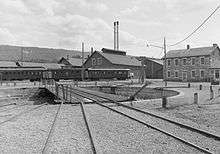Sioux City & Pacific Railroad Co. v. Stout
| Sioux City & Pacific R.R. Co. v. Stout | |||||||
|---|---|---|---|---|---|---|---|
|
| |||||||
| Decided January 26, 1874 | |||||||
| Full case name | Sioux City & Pacific R.R. Co. v. Stout | ||||||
| Citations |
21 L. Ed. 745; 17 Wall. 657 | ||||||
| Court membership | |||||||
| |||||||
| Case opinions | |||||||
| Majority | Hunt, joined by unanimous | ||||||

A railroad turntable similar to this one was thought to breach the duty to children trespassers because it induced them to trespass.
Sioux City & Pacific Railroad Co. v. Stout, 84 U.S. 657 (1873), was a case decided by the Supreme Court of the United States that first enunciated the idea that a landowner could be liable for the injuries of a child trespasser.
Decision
A child was injured by a railroad turntable owned by Sioux City and Pacific Railroad, and the company was held liable despite the prevailing idea that a landowner was not held liable for injuries to trespassers. Trespassing children were thought to be a special case that required a higher duty of care. This theory of liability came to be known as the "turntable doctrine" and later the attractive nuisance doctrine by the case Keffe v. Milwaukee & St. Paul R.R. Co.
See also
- Chicago B. & Q.R. Co. v. Krayenbuhl: A similar case
- List of United States Supreme Court cases, volume 84
External links
- Text of Sioux City & Pacific R.R. Co. v. Stout, 84 U.S. 657 (1873) is available from: Findlaw Justia
This article is issued from Wikipedia - version of the 2/14/2015. The text is available under the Creative Commons Attribution/Share Alike but additional terms may apply for the media files.
